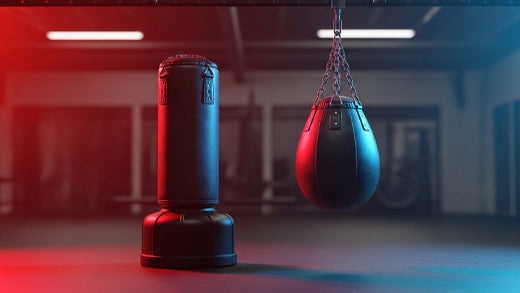The Flicker Jab stands out as one of the most strategic forms of lead hand strikes, relying on speed, rhythm, and deception rather than punching power alone. It is a strategic weapon that some of the greatest boxers, like Floyd Mayweather, often used during their fights.
At Sting Sports, we understand that true mastery of boxing comes with mastering different techniques that distinguish good fighters from great ones. One such subtlety is the flicker jab, a calculated tool of rhythm and control designed to dart out with minimal telegraphing while snapping back at just the last second.
What Is the Flicker Jab in Boxing?
The flicker jab in boxing is one of the most deceptive and fast-paced punches in the sport. It is a fast, whip-like punch thrown with a loose and relaxed arm. The traditional stiff jab is thrown with a rigid arm and full body weight to create a powerful blow, whereas the flicker jab prioritizes deception, speed and frequency.
This punch is not thrown to achieve a knockout. It is a calculated tool of rhythm and control, designed to dart out with minimal telegraphing, snapping the wrist at the last second to flick the opponent's face or head. This constant, light tapping is frustrating, scores points, and most importantly, controls the distance of the fight.
The Flicker Jab's Origin
Many fighters wonder who invented the flicker jab? This jab was popularized by the great legend Tommy “Hitman” Hearns. He is famous for being the one who started it. The Thomas Hearns jab became his signature, paving the way for other boxers. Then, legends like Muhammad Ali and Naoya Inoue refined the concept of the flicker jab. This technique has its roots in the long history of combat sports.
In modern-day boxing, Floyd Mayweather and Tyson Fury kept the torch alive. Over time, the flicker jab turned into a legacy move.
Flicker Jab vs Normal Jab: The Mechanical Difference
The Comparison between flicker jabs vs regular jabs illustrates that their differences lie solely in the biomechanics of force application and recovery, necessitating fighters to switch focus from raw strength to fast-twitch muscle activation for maximum effectiveness.
The Standard Jab: Power and Structure
The standard jab is a structural, driving punch:
-
Execution: Thrown with a fully extended arm and shoulder rotation.
-
Purpose: Hurting, creating structural distance, and maintaining position.
-
Movements: Slow to retract due to body weight commitment.
The Flicker Jab: Speed and Deception
The flicker jab in boxing is a rhythmic, fluid motion that uses leverage and quick return speed. It uses the science of speed rather than raw power.
-
Execution: Thrown with a loose, relaxed arm; the elbow leads, and the wrist snaps sharply at full extension.
-
Purpose: To disrupt the vision and rhythm of the opponent, conserve energy and score points.
-
Movement: Instant, quick recoil to make sure the hand goes back to guard before the opponent can respond.
How to Throw a Flicker Jab
Learning to throw a flicker jab requires patience and control over raw power. Here's how it should be executed effectively:
-
Position: Maintain a light bounce in your boxing stance; stay mobile.
-
Hand Placement: Place the lead hand slightly lower than shoulder height for quicker release.
-
Execution: Snap out your jab quickly while shifting only minimal shoulder movement, and flicking your wrist at the end of each punch.
-
Speed Over Power: Your goal should be to land multiple quick strikes rather than one powerful blow, returning immediately after contact to reset your defenses and recover quickly.
Here is a video tutorial explaining how to throw a Flicker jab:
Using the Flicker Jab in Boxing
Exercising this move while using boxing hand wraps provides wrist protection and helps maintain proper form during repetitive drills.
Strategic Benefits for the Fighter
The flicker jab in boxing is an essential strategic tool for maintaining control and setting up devastating combinations.
|
Jab Variation |
Primary Strategic Goal |
Key Performance Benefit |
|
Flicker Jab |
Rhythm Control / Distraction |
Conserves energy while obscuring the opponent's vision and setting up the power hand. |
|
Power Jab |
Stun / Structural Damage |
Forces the opponent backwards, breaking their stance and setting up clinches or follow-ups. |
|
Range-Finder Jab |
Distance Management |
Thrown lightly and quickly to gauge striking range before committing the rear hand. |
|
Pivot Jab |
Angling / Punching Force |
Thrown while stepping and pivoting the lead foot to put maximum body mass behind the punch. |
Equipment Focus: Wrist Support and Durability
Although flicker jabs use less raw power than traditional jabs, the repeated snapping motion of your wrists requires exceptional support in order to avoid long-term strain or injury.
At this point, choosing the best hand wraps becomes an essential accessory for protection and comfort during repetitive flicker jab drills.
-
Stabilizes Joints: Provides stability to the wrist and knuckles, mitigating the risk of sprains or strains from the whip-like motion.
-
Boosts Confidence: The athlete can punch as hard and as often as they want without fear of joint failure.
Whether you are learning how to throw a flicker jab for the first time or perfecting it for competition, reliable hand wraps provide the foundation necessary for mastering this speed-and-timing-dominated technique.
Common Mistakes when Throwing Flicker Jab
Some of the common mistakes boxers make when throwing a flicker jab include:
-
Overextending: Don't lunge forward with the flicker jab. Overextending can cause you to lose balance and make you vulnerable to a counterattack.
-
Neglecting Defense: Snap your hand back to the guard position quickly after throwing a flicker jab. It’s easy to get caught up in the offensive aspect and forget about your defense.
-
Telegraphing: Keep changing the rhythm and target of your flicker jabs. Becoming too predictable may allow your opponent to time their counters more effectively.
-
Too Much Power: The flicker jab uses speed, not power. Because of this, you don't need to warn your opponent by moving back or lifting your arm.
The flicker jab is all about rhythm. Don't treat it like a punch and start treating it like a rhythm tool; it will be highly effective.
The Takeaway
Flicker jab is not only a punch in boxing but also a strategy that defines the rhythm, timing and control of the boxer. It is a subtle yet strong weapon that a boxer has. The effectiveness of the flicker jab lies in its ability to surprise and confuse an opponent. Like any technique, the flicker jab requires practice and timing to be executed effectively.
At Sting Sports, we understand that true mastery of boxing comes with mastering different techniques that distinguish good fighters from great ones. One such subtlety is the flicker jab, a calculated tool of rhythm and control designed to dart out with minimal telegraphing and snapping back at just the last second.
FAQs
Q1. What is the primary objective of the flicker jab?
It assists in keeping distance, breaking the rhythm of an opponent, and providing the possibility of follow-up punches.
Q2. Who invented the flicker jab?
The flicker jab technique has been popularized in professional boxing by Thomas “Hitman” Hearns.
Q3. Is a flicker jab more powerful than a regular jab?
No, the flicker jab is all about speed and control over power, whereas the normal jab provides greater force.




